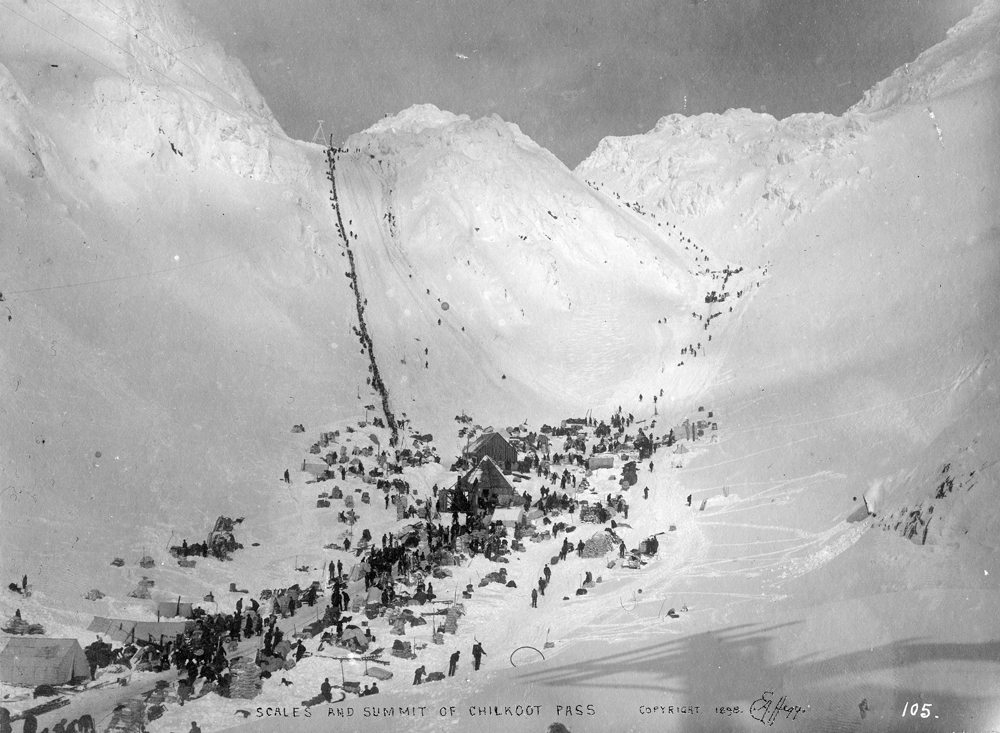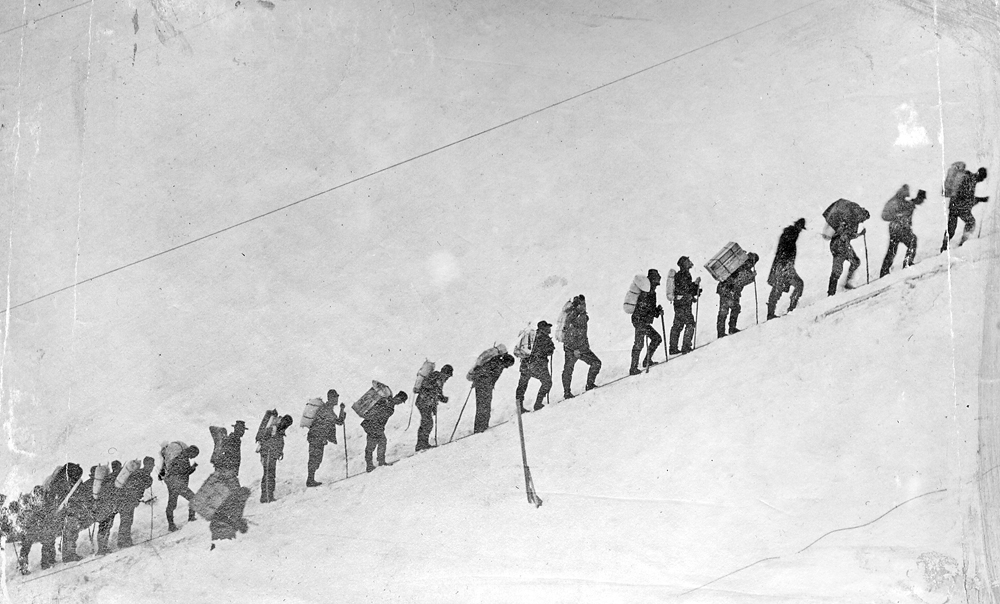The Klondike’s Golden Staircase
Yesterday I happened across a photo from the late-nineteenth century Klondike Gold rush of the part of the Chilkoot Pass that was known as the Golden Staircase. You can see why the photo caught my attention:
Here’s one that’s more of a closeup, to see what they were carrying up that mountain staircase:
I’m not quite sure why that was called a pass. Looks an awful lot like a mountain to me, but I guess it’s a low one. People were awfully tough back then. Here’s more about the Staircase:
The twenty-six mile trail over Chilkoot Pass was steep and hazardous. Most stampeders who gave up did so attempting to cross the mountains.
In the winter, stampeders struggled in blizzards, snow, frigid temperatures, and avalanches. The trail shot up about 1,000 feet in the final half mile. Stampeders climbed the “golden staircase,” 1,500 steps cut in the snow and ice, and used a guide rope for support…
Travelers did not always fare better in the summer. Stampeders struggled in rain, fog, boulders, and bogs. Without its covering of snow and ice, the trail to the summit led over giant boulders over which people literally crawled.
To move one outfit over the pass, stampeders packed and cached their goods up to forty times and hiked up to 1,000 miles. The terrain on the last four miles of the trail was too rough for pack animals. Discarded supplies littered the trail as stampeders cast unnecessary items aside. Many took three months to move their goods from Dyea to the summit.
The name “Golden Staircase” quite obviously describes the goal at the end of the arduous journey: gold. The staircase itself was made of ice and snow. But the phrase jogged a memory for me of a song lyric, and Google helped me find the sources. It’s a common metaphor for the route to heaven, in the Salvation Army hymn called “Climbing Up the Golden Stair” as well as the one with which I’m familiar, Peter Paul and Mary’s rendition of “Early in the Morning” (second verse, “won’t you guide me safely, to the golden stair”):



> People were awfully tough back then.
Yes, they were. It is hard to comprehend from our present comfort just how tough they were.
Great post. I love these posts that take our minds off of the hysteria.
When I was in junior high, we used the word “Klonkdike” to mean idiot/food/turkey. That definition did not make Urban Dictionary
James Michener’s book “Alaska” includes this climb, by early pioneers.
Micheners “Alaska” has a whole chapter on this. I recommend the book.
My relatives in the Pacific Northwest once loaned me an old book that had a vivid description of those scenes, a first-hand account written by one of those men in the Gold Rush. That pioneer went from working in the salmon canneries in Washington, then headed north when gold was found. He did find gold, eventually, but only a very modest profit, once his supplies and time were accounted for.
The description of what those people went through, as a matter of course, is quite surprising compared to what we are used to and expect today. All of those people were exceptionally hardy and uncomplaining. A miner would have to haul in a ton of supplies (enough to last a year) on his own, moving it in stages, and even having to build his own boat to reach the goldfields. The miners also set up their own committees to deal out justice.
Incidentally, our current President’s grandfather, Frederick Trump, also participated in that gold rush, but not by mining. Instead he grew wealthy by running the Arctic Restaurant and Hotel from 1898 to 1901, then later moving to NYC by 1902, after he got married. The rest is history, as they say.
hmm, maybe i should read the comments before commenting 😉
And remember, they had leather shoes or boots, cotton and/or wool clothing, socks, coats. Carried their belongings in sacks or bags, on their backs.
No nice Gore-Tex(R) or polar fleece, no “wicking” undergarments. No backpack with cute zippered & separated pockets for this ‘n that.
If you’ve ever been out in snow and frigid air dressed in wet wool socks and pants, you’ve intimate knowledge of the words “really, really cold.”
Chaplin’s “The Goldrush” is a terrific movie about this with some of his greatest scenes including the dancing bread rolls.
https://youtu.be/8iUWmp3KJT4
The entire movie appears to be available on You Tube.
When I went to the source I page I really noticed the people carrying a wooden chest on their backs.
One has to start having second thoughts half way up, I would think.
It’s a pass because it’s a relatively lower saddle between higher peaks. Saw it once, never fool enough to climb it.
I read Jack London’s “To Build a Fire” and “A Hundred Dozen Eggs” in high school about the hardships suffered in the Yukon during the Gold Rush.
I was scarred for life!
A pass IS a mountain; it’s just lower than the other mountains around it. It’s the lowest point in the local range but the highest point of the road.
At Christmas my sisters and I used to drive from Santa Fe to a small town above Colorado Springs. On the way we would have to drive through Raton Pass. If it had been snowing heavily — as happens around the holidays at 7800 feet — it was a white-knuckle horror to drive through.
One year was particularly bad. We saw at least a dozen cars which had spun out on the road and were stranded on the shoulders.
A certain amount of Raton, NM’s tourist business is based on drivers stuck in Raton because the pass is closed.
Anyway here’s the late, great Townes van Zandt singing “Snowin’ on Raton”:
https://www.youtube.com/watch?v=2NgjYhzrTgE
Rich:
I’ve driven through many passes. The ones I’ve been through do NOT go straight up a mountain like that!
They certainly are not at sea level; they are very high. But they usually run somewhat between mountains although at a high high elevation. At least, that’s been my experience. I’ve never seen a pass that goes straight up either a mountain or a foothill at that kind of steep angle.
Neo:
Photography can fool the eye.
And for the tropical version of a grim horrible experience there is the Kokoda Track in New Guinea WWII.
There were two passes. This one and the White Pass. The trail for the White Pass is still visible along the side of the pass.
They said that whichever pass you chose, somewhere along the way you wish you had taken the other one.
Both passes had to be climbed several times to carry provisions to the top. Nobody was allowed to cross into Canada unless he had enough supplies. A ton of material comes to mind but whatever it was, it was a lot and couldn’t be hauled up in a single climb.
I admit I was hoping to get a shout-out from a Townes’ fan or two about “Snowin’ on Raton.”
No matter. He was a great sixties-seventies county singer with manic depression who didn’t end well — like Phil Ochs.
I had heard of him, but I didn’t pay particular attention until the Cowboy Junkies “Black Eyed Man” album, which included the lyric:
Ain’t this fool ever heard of Raton?
https://www.youtube.com/watch?v=7a58lXH14YU
Which was about Raton Pass and Townes’s magnificent song, “Snowin’ on Raton.”
I don’t buy the rhetoric Townes was on par with Bob Dylan, but Townes was something else for those at all inclined to his sound.
Apparently, there’s another “Rich” posting on this thread. So from now on, I’ll use “Rich F”